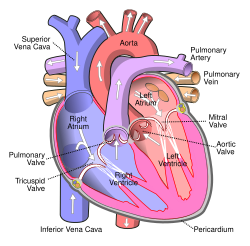Aortic valve
| Aortic valve | |
|---|---|
|
Frontal view of the Aortic valve
|
|

Aortic valve
|
|
| Details | |
| Identifiers | |
| Latin | valva aortae |
| TA | A12.1.04.012 |
| FMA | 7236 |
|
Anatomical terminology
[]
|
|
The aortic valve is a valve in the human heart between the left ventricle and the aorta. It is one of the two semilunar valves of the heart, the other being the pulmonary valve. The heart has four valves and the other two are the mitral and the tricuspid valves. The aortic valve normally has three cusps or leaflets, although in 1–2% of the population it is found to congenitally have two leaflets.
The aortic valve normally has three cusps – a left, right and posterior cusp.
When the left ventricle contracts (systole), pressure rises in the left ventricle. When the pressure in the left ventricle rises above the pressure in the aorta, the aortic valve opens, allowing blood to exit the left ventricle into the aorta. When ventricular systole ends, pressure in the left ventricle rapidly drops. When the pressure in the left ventricle decreases, the aortic pressure forces the aortic valve to close. The closure of the aortic valve contributes the A2 component of the second heart sound (S2).
Narrowing of the aortic valve is called aortic stenosis, limiting the blood that can leave the valve and increasing the force the heart has to use to pump the blood through the valve. Aortic insufficiency, also called aortic regurgitation, is when the valve is unable to close properly. Blood consequently flows passively back to the heart in the wrong direction. These two conditions frequently co-exist. Common causes of aortic regurgitation include vasodilation of the aorta, previous rheumatic fever, infection such as infective endocarditis, degeneration of the aortic valve, and Marfan's syndrome. Aortic stenosis can also be caused by rheumatic fever and degenerative calcification.
...
Wikipedia


